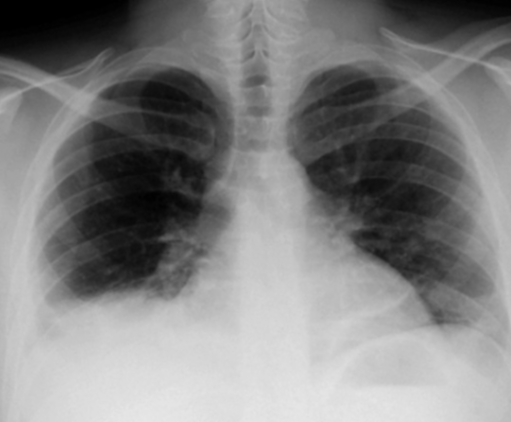Presentation of a Case
A man who was 24 years old went to the emergency room because his shortness of breath had been getting worse over the past week. The patient’s medical and family stories were not interesting. But it turned out that he had been drinking 8 to 10 cans of energy drinks every day for two weeks before he went to the hospital (3.5 to 4 L/d). He said he felt tired and short of breath three days after drinking his first energy drink. He had orthopnea, contralateral widespread rales, and 2+ pretibial swelling when he was examined.
Look into it
A heart rate of 110 beats per minute was seen on the electrocardiogram (ECG), along with T-wave reversal in leads V4 to V6. On the lung X-ray, there was a swollen spot in the lower right corner. A CT scan of the chest showed pulmonary swelling and pleural effusion. The left ventricular echocardiography showed that the left ventricle had a 25% ejection fraction, end-diastolic diameters of 62 mm and 52 mm, an interventricular septum of 7 mm, and a posterior wall of 6 mm. The left ventricle was also bigger than normal and had global left ventricular hypokinesia.
The right ventricle was the right size and worked normally. The patient was taken to the hospital after being told they had severe heart failure. Also, the causative study was done after the diuretic treatment and symptom improvement. Heart X-rays showed that the coronary vessels were in good shape. Two months after the finding, a coronary MRI was done. The heart pumping blood had a volume of 169 mL at the end of systole and 229 mL at the end of diastole. There was a 7 mm gap between the ventricles and a 26% ejection rate. The systolic function was also lowered, and the left ventricle got bigger. It was found that there was no clinical change.
The right ventricle worked normally in cine images. The echocardiographic results did not get better at the follow-up visit six months later.
Talking About
Too many energy drinks have been linked to serious problems with the heart and brain. From a brain point of view, there have been many reports of seizures. Heart problems like palpitations, arrhythmias, and cardiac events are the most common ones that are mentioned.
The most caffeine that should be taken in a day is 400 mg, and 4 g or 10 g of caffeine is dangerous and can kill you. Guarana, which is another low-amount ingredient, has been used for thousands of years to speed up the heart. Guarana has more caffeine than coffee beans. It also has xanthine alkaloids, such as theobromine and theophylline. On the other hand, L-carnitine has been shown to improve angina and cardiac arrhythmias, while taurine has been shown to cause these conditions by decreasing the action potential. These two amino acids are found together in energy drinks and work in different ways.
When you drink beer or use other drugs at the same time, the affects of energy drinks can get stronger. When caffeine is mixed with booze, its half-life is pushed back by 72%.
This person liked to drink with other people. And he didn’t say that he used vasospasm-inducing drugs like cocaine at the same time. It was ruled out that the patient had hypertrophic heart or Prinzmetal’s angina.
People usually expect their hearts to work better after the severe infection phase is over.
Rhythm Holter tracking was done on the patient for 96 hours. There was no dysrhythmia to be found. Even though he was getting the best medical care and his rate was being controlled, his ECG at the time of entry showed a sinus rhythm. And at the 6-month follow-up, there had been no change in his ejection fraction. An endomyocardial biopsy, which is the best way to diagnose cardiomyopathy, could help rule out other possibilities.

